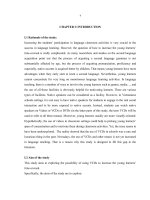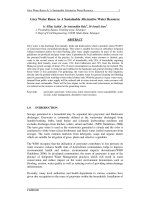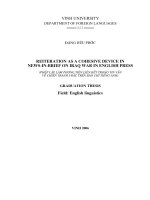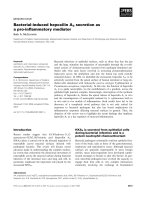grey water reuse as a sustainable alternative resouree
Bạn đang xem bản rút gọn của tài liệu. Xem và tải ngay bản đầy đủ của tài liệu tại đây (447 KB, 7 trang )
Grey Water Reuse As A Sustainable Alternative Water Resource
1
_______________________________________________________________________________
CAFEO 28
Grey Water Reuse As A Sustainable Alternative Water Resource
Ir. Ellias Saidin
1
, Dr Aminuddin Baki
2
, Dr Ismail Atan
2
1. Perunding Ikatan, Petaling Jaya, Selangor
2. Dept of Civil Engineering, UiTM, Shah Alam, Selangor
ABSTRACT
Grey water is the discharge from laundry, baths and dishwashers which constitutes about 50-80%
of wastewater from a household discharge. This water is suitable for reuse in subsurface irrigation
without treatment and/or for toilet flushing after some simple treatment. In parts of the world,
guidelines are produced and grey water reuse is permitted by local authorities amidst concern over
the potential health hazard of the practice. In Australia, where water resource is limited, grey
water is the second source of water in 55% of households; with 25% of households reporting
collecting their laundry water for reuse, 19% from bathrooms and 13% from the kitchen. In
Malaysia typical savings of about 37% of water consumption in a household may be realized. The
safe reuse of grey water is restricted and confined to the landscape and general cleaning within the
home where it was generated. For gardening, the water has to be dispersed by drip irrigation,
directly into the ground within twenty-four hours. Laundry water for general cleaning and flushing
must be generated from washing of non-soiled clothes only. With the practice of grey water reuse,
demand from public water supply will be reduced and in water stressed areas, water resource will
become more sustainable. There will be less impact on the stream and watercourses as discharge
are reduced as the resource is reused at the generating source.
Keywords: greywater, graywater, water reuse, water conservation, water sustainability, water
recycle, water management, alternative water resource.
1.0 INTRODUCTION
Sewage generated in a household may be separated into greywater and blackwater
discharges. Greywater is commonly defined as the wastewater discharged from
laundry/washing, baths, hand basins and (cleaned) dishwashing machines and
excludes discharges from kitchen, toilets, urinal and bidet. (NSW Guidelines, 2008)
The term grey water is used as the wastewater generated is cloudy and the color is
contrasted to white water (clear freshwater) and black water (soiled wastewater from
sewage). The water contains nutrients from detergents, soaps and organic matter
which are suitable for irrigation of grass, plants and selective vegetables.
The WHO recognise that the utilisation of greywater contributes to less pressure on
water resource, reduces health risks of downstream communities, helps to improve
environmental health and reduces environmental impacts downstream.(WHO
Guidelines 2006). In developed communities, the reuse of greywater is part of the
practice of Integrated Water Management practices which will result in water
conservation and reduce impact on the water environment downstream such as
flooding, erosion, water quality as well as reducing costs of providing urban drainage
infrastructure.
Presently, many local authorities and health department in various countries have
given due recognition to the reuse of greywater within the households. Installation of
Grey Water Reuse As A Sustainable Alternative Water Resource
2
_______________________________________________________________________________
CAFEO 28
a greywater system can be carried out in homes by complying with Guidelines and
Regulations issued by the authorities for the safe utilisation of this water resource.
In Europe, Australian and USA where the International Plumbing Code is adopted,
grey water from showers, bathtubs and hands basin can be used for toilet flushing
leading to over 30% of a domestic demand. (Chap 13, International Plumbing Code).
The City of Malibu, California passed laws in 1994 on the standards for greywater
systems for installation in homes. However it was also reported that in 1992, 8% of
beachfront home and 33% of inland homes were already using some form of
greywater systems.
In 2001, The Arizona Department of Environmental Quality issues guidelines and
permits the use of graywater within a residential property generating less than
400gallons per day, for subsurface irrigation within the premises. The water table has
to be a minimum 5 ft blow ground, and discharged at 4 feet away from building
foundations, and the soil has to be sufficiently permeable without percolation on the
surface. (Val L Little, 2001).
The States in Australia have regularly updated their Guidelines for the installation of
greywater systems in the home to be carried out by licensed plumbers and have issued
certificate of approvals for greywater systems. Grants are offered to Australian homes
installed with greywater systems. The government of Cyprus offer subsidies of up to
€1700 for the use of greywater in a home. In Tokyo, greywater is mandatory for
buildings >30,000 m2 or with potential non-potable demand of more than 100m3/day.
(Environment Agency, 2008).
Health safety concerns on the reuse of greywater
within the home are minimal as pathogens are
usually killed after being placed in the soil.
Pathogens are not spread to others as atmospheric
spraying is not permitted as it generates droplets or
aerosols for transport to neighbours. Family
members are not at high risks even if in contact with
these water borne pathogens as there are body
contacts and other means of contacts for pathogens
to cross contaminate within the home.
An agricultural concern is the high concentration of
salts especially sodium in detergents which inhibit
seed germination and breaks down the clay
molecules in soil.
Japanese Cascading Toilet Bowl
2.0 THE QUALITY OF GREY WATER
The NSW Guidelines conveniently identifies two greywater streams; bathroom
greywater and laundry greywater. The bathroom greywater contains soaps but of very
low concentrations that makes the moisture easier to move around the soil particles.
The dead skin cells and little body wastes from sweat and other organs contains
nitrates and minerals which are highly nutritious for the plants.
Grey Water Reuse As A Sustainable Alternative Water Resource
3
_______________________________________________________________________________
CAFEO 28
The laundry greywater is more contaminated with faecal pathogens from soiled
clothing than the bathroom source, though laundry water is easier to capture and use.
Laundry water contains phosphates and human organic matter for healthy plant
growth.
The quality or greywater is highly dependent on the detergents, soaps and household
practices.
A typical composition of greywater from a Western Australia home is reproduced
below from West Australia Water Corporation Draft Guidelines 2002.
3.0 HOUSEHOLD GREYWATER QUANTITY
The quantity of greywater available for reuse in a household may be estimated from
the daily household consumption. The consumption for a typical home in WA,
Australia and Malaysia are shown below.
Source: Western Australia Water Corporation (2002) Source: Bulletin JKR & Alam Sekitar (2006)
Grey Water Reuse As A Sustainable Alternative Water Resource
4
_______________________________________________________________________________
CAFEO 28
The figures indicated that 29% (WA) and 46 %( Malaysia) of the household
consumption may be safely reused without treatment with up to 40% and 70%
respectively available for reuse after basic treatment. It is noted that in WA where
garden watering constitutes 47% of daily water demand, the reuse of greywater is
most encouraging to conserve water demand in the home.
4.0 GREY WATER REUSE SYSTEMS
A greywater System may be varied in complexity from the direct reuse systems with
no treatment, basic physical and chemical treatment and the more complex biological
and bio-mechanical treatments systems which will allow for longer storage periods.
The more complex systems are applicable in a high consumption and large population
condition and have been reported in the UK to be quite unreliable in terms of
performance such as odour and water quality.( UK, Environment Agency; 2008)
In a household in Australia, the NSW Government permits the reuse of household
greywater in three categories. The first category is where the untreated greywater is
diverted through pipes to be used in lawn subsurface irrigation within the premises.
The second method is where the greywater is partially treated to be reused in toilet
flushing, laundry washing and open irrigation. The third category is where the
greywater is manually carried in buckets. (NSW Guidelines 2008).
The components of a Greywater Reuse System are the Source, Piping and
Conveyance, Surge/Balancing Tanks, Filters, Pump and delivery piping system. A
separate sanitary plumbing system has to be installed to separate the grey water from
the wastewater discharges in a home. Some allowance for treatment by chlorination
may be necessary where the water has fouled up.
Components in a Greywater Drip Irrigation System
Source:
The amount of water to be used shall be balanced against the demand requirements of
the lawn, vegetables or other user demand. The surge tank should not store the
greywater for more than 24 hours to avoid odour and microbial problems unless
Grey Water Reuse As A Sustainable Alternative Water Resource
5
_______________________________________________________________________________
CAFEO 28
chemical and/or microbial treatment is provided. The pumping flow rate needs to be
matched with the infiltration capacity of the soil with the water being preferably fed
through subsurface drip piping systems which feed directly the roots of the plant.
The water shall not be sprayed or otherwise applied so as not to form airborne
aerosols. Overflows and bypass systems must be installed for the greywater to
overflow into the municipal wastewater system when there is excess or during heavy
rains.
Under the NSW Code of Practice, 2006; reywater discharges from the laundry and
bathroom may be reused through Greywater Diversion Devices (GDDs) without any
treatment process. However to reuse kitchen greywater a Greywater Treatment
Systems (GTSs) has to be installed before the water can be reuse either for toilet
flushing, laundry and surface and/or sub-surface irrigation outdoors.
It is better to install the greywater system during construction as retrofitting is costly
and with long investment return periods. Although communal systems may be more
reliable in terms of matching supply/demand and water quality, however public
perception and acceptability has to be overcome.
5.0 STUDIES OF GREYWATER REUSE
Texas A&M El Paso Research Center studied the effects of using greywater (laundry
water) discharged from a prison (3,500gpd) on vegetable and cotton crop plots in an
arid area receiving less than 250mm of rain. The center concluded that graywater was
a good alternative source for irrigation and also landscaping.
Mature Cotton plants
Photo: Texas A&M University
The Water Environment Research Foundation, USA carried out a study where it was
concluded that there were no apparent long term effects of landscape irrigation using
household greywater on landscaping plants; the soil microbes seem to benefit from
the nutrients however subsurface irrigation is recommended to reduce pathogenically
contamination.(WERF;11/2007)).
Young Tomato Plants
Photo: Texas A & M University









